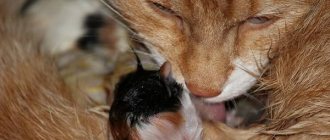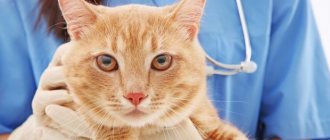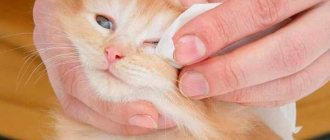7712Administration
The birth of kittens and postpartum recovery of the body are considered normal events in the life of a cat who has given birth. And if a cat has bleeding after giving birth, then this can be considered a natural process that accompanies the removal of remaining tissue, blood and mucus from its body. However, situations in which such discharge appears too long after the animal has finished giving birth require certain actions on the part of the animal owner to prevent possible adverse reactions to the health of the pet.
Normal discharge
Safe manifestations of the postpartum period include:
- the cat bleeds immediately after birth and for 24-48 hours;
- the discharge contains patches of green or brown for seven days;
- Clear, odorless mucus comes out of the genitals; this continues for up to two weeks.
New mother cat
For your information! The recovery process takes place without any extraneous symptoms such as fever, lethargy, refusal to eat or neglect of children and communication with the owner.
Symptoms of pathological discharge
Of course, the main clinical sign for all these pathologies will be vaginal discharge, but various variations are still possible due to the deterioration of the animal’s general condition:
- As we have repeatedly written above, pathology should be suspected if any uncharacteristic discharge appears immediately after childbirth or a few days after it.
- At the same time, cats begin to constantly lick the genital area. Sometimes they get so carried away by this activity that they even stop caring for their kittens.
- Often, with inflammatory diseases of the genitourinary system, the pet experiences severe pain, which is why it begins to behave inappropriately. She constantly runs, meows, and can literally roll on the floor. The animal cannot even feed the kittens normally. However, in such cases, we would recommend feeding babies artificially, since pathogenic microflora can get into the milk.
- A fairly characteristic symptom is constant, non-stop urination. This happens because the cat is constantly pushing.
- For the same reason, constant “big” hikes or involuntary bowel movements are possible. Due to the constant mixing of discharge from the genitals and feces, brown discharge may be observed.
- Apathy, feverish state, sharp increase in thirst.
Remember that if your pet is in a lethargic state and (especially) a noticeable drop in its overall body temperature, you must immediately call a veterinarian. These signs indicate septic processes. If you delay, your cat may very well die.
Dangerous postpartum discharge in cats
Pet owners should pay special attention to unusual postpartum phenomena. They may report the development of serious illnesses.
Inflammation of the uterus
Discharge from a pregnant cat: bloody, yellow
Metritis develops within 72 hours after the end of labor. During its development, the animal suffers:
- from fever;
- becomes depressed;
- refuses to eat and drink;
- leaves the kids.
The inflammatory process in the tissues of the uterus occurs under the influence of increased activity of pathogenic bacteria, incomplete delivery with the remaining dead fetus. The cat may experience bouts of vomiting and diarrhea, followed by dehydration. Discharge from the genitals has a characteristic unpleasant odor and contains particles of pus.
Important! When examining and palpating the abdominal wall, increased muscle tone is felt and the pet experiences pain. An enlarged uterus is the main sign of metritis.
Postpartum injuries
Inept obstetric care during childbirth, the use of drugs to intensify or slow down contractions, and damage to large vessels lead to hemorrhages. It is impossible to solve the problem on your own; in most cases, the cat requires surgical intervention.
How is the operation performed?
Genital infections
The penetration of pathogenic microflora leads to inflammation of the mucous membranes of the genitals. The infection occurs both during labor and in the postpartum period. The sources of the disease are considered to be poor hygiene, a dirty place, and accidental introduction of bacteria during childbirth through unsterile instruments.
The pet begins to secrete a thick and abundant secretion of a greenish color, and a fever appears. The animal constantly licks itself due to unpleasant sensations: irritation and itching.
Soft tissue ruptures
Damage occurs under the following conditions:
- placenta accreta;
- merging several children's places into one chain;
- large kittens.
Note! Dangerous consequences of labor include ruptures of the muscle tissue of the uterus with severe blood loss. The use of stimulants also negatively affects the organ and increases the risk of damage.
Malignant formations
A cancerous tumor inhibits the activity of the immune system and damages the uterus. Formed oncology leads to bloody discharge with particles of pus and a strong unpleasant odor as a consequence of the destruction of the malignant neoplasm.
Vaginitis
Inflammation of the soft tissues of the vagina is divided into acute and chronic. Ulcerations on the surface of the mucous membranes provoke discharge of different colors:
- clear or cloudy;
- yellowish-whitish viscous;
- purulent-mucosal in nature.
Important! Treatment of a mild form of vaginitis consists of douching with an antiseptic solution, while a complex form is treated with antibiotic therapy.
Pyometra
Severe inflammation of the uterus is manifested by the cat's constant licking of its genitals, brownish spots remaining on any surface where the furry pet was located. Secondary signs of pathology include:
- bloating;
- febrile syndrome;
- severe thirst and refusal to eat;
- frequent urination;
- lethargy and decreased motor activity.
For your information! In complex cases, discharge with pus appears before the clinical picture of pyometra.
The uterine walls cannot withstand the load, rupture, the accumulated contents pour into the abdominal cavity, leading to peritonitis. The disease causes death.
What to do if there is bleeding?
Often, when blood discharge is detected in a pregnant cat, owners begin to panic and try to help the animal at home. A favorable outcome in a pathological condition largely depends on how quickly and competently assistance is provided. If any heavy discharge with an odor is detected, the cat should be taken to the veterinarian. After examining the patient, performing an ultrasound and taking samples, the doctor decides on further treatment tactics.
There are several common reasons for miscarriage. It can be:
- genitourinary infections – toxoplasmosis, chlamydia and others;
- abdominal injuries, falls from great heights;
- uncontrolled mating;
- congenital pathologies of the pelvic organs in cats;
- inbreeding leading to genetic abnormalities.
Diagnosis and treatment
What to feed a cat after giving birth: proper nutrition and care
Complaining that a cat has bleeding on the second day after giving birth leads to the need for a full diagnostic examination. The veterinarian conducts a general examination, palpates the abdomen, and sends the pet for an ultrasound and x-ray. After the diagnosis is made, symptomatic therapy is carried out.
- With minimal bleeding caused by artificial stimulation of labor, hemostatic drugs are prescribed. If massive blood loss is observed, the animal will have to undergo surgery.
- In case of inflammatory processes, antibiotic therapy is carried out, medications are prescribed to increase the tone of the uterus. With their help, remnants of placenta tissue are removed from the organ and pathogenic microflora is destroyed.
Important! Elevated body temperature requires isolation of babies from their mother and transfer of kittens to artificial nutrition.
Artificial feeding
Can a cat be given Oxytocin after giving birth?
In the last century, Oxytocin was a fairly common drug used after childbirth. At the moment it is considered somewhat outdated, however many veterinarians use it very successfully. This drug stimulates contractions, but it is not recommended for use either immediately before birth or at the time of labor resolution, because the animal may have uterine rupture against this background. Oxytocin is widely used during the expulsion of the placenta, that is, when all the babies are born.
If the owner has given Oxytocin and the pet is bleeding brightly, then this is a clear sign of uterine rupture. In this case, the cat must be taken to the veterinarian as quickly as possible. If the bleeding is dripping, then a hemostatic drug can help in this situation. When the discharge is abundant, nothing will help her except surgery.
Rules for caring for a cat during the postpartum period
Stress in a cat: symptoms, after moving, what to do
Veterinarians advise adhering to standard requirements for caring for a woman in labor. Ignoring them can lead to serious illnesses and require long-term therapy for an animal weakened by labor.
Nutrition
Feeding is carried out according to the standard principle with the usual portions being doubled. A sufficient amount of food will help feed the babies and prevent exhaustion of the cat and insufficient milk production. Don’t get carried away with culinary delights; ready-made food will provide the young mother’s body with all the necessary vitamins and minerals.
Hygiene
A healthy animal does an excellent job of caring for itself. If postpartum complications arise, she needs the help of her owner. The problem of matted fur in the genital area and on the hind legs is solved with the help of wet wipes.
Temperature control
Regular testing will allow timely detection of deviations from normal values. Why is it done three times a day:
- if the level exceeds 38 °C, the deviation is associated with infection;
- if below standard values, there may be a risk of hidden internal bleeding.
Temperature measurement
Prevention of pathology
To prevent the development of abnormalities in the postpartum period, you must adhere to the following rules:
- stop abusing hormonal drugs that are used to control estrus: it is prohibited to independently increase the dosage and duration of use;
- comply with the requirements of antiseptics during labor, carry out hygiene procedures after childbirth for a young mother who does not know how to care for herself;
- Before mating, check the cat’s health to ensure that he does not have genitourinary infectious diseases;
- Any discharge during pregnancy is a reason for an emergency visit to the veterinarian.
The birth of babies is a serious stress for their mother's body. Maximum efforts are required from the animal owner to facilitate the birth and postpartum periods. Blood during childbirth in a cat is a standard manifestation, but its excessive amount should attract the attention of the owner. Ignoring deviations can cost not only the health, but also the life of your furry pet.
Reasons for appearance
Complications during pregnancy are accompanied by discharge, and when it appears, the animal is provided with medical care. The process occurs before childbirth or after active contractions.
Main reasons:
- Inflammation in the reproductive organs or tissues near them.
- The danger of miscarriage is accompanied by bleeding.
- A binding substance is released that forms a mucus plug, and a yellow discharge is formed.
- Damage to the uterus.
- Separation of the placenta.
- A bad smell and brown mucus with a greenish tint comes out of the loop.
White vaginal discharge in a cat may appear due to natural causes. They can be detected when the animal is in estrus or heat.
During the period of estrus, discharge from a female’s snare can be observed, which has the following characteristics:
- transparency;
- no odor;
- homogeneity.
Normally, they will be observed for several days. Usually the owner does not notice these signs of estrus, since the female immediately licks them. If such a picture is observed for a long time, then the characteristics of the discharge begin to change. They change consistency and color (blood spots appear), and also acquire an unpleasant odor. This is no longer normal, and the animal must be shown to a doctor.
Normally, cats should not bleed during estrus. It serves as a harbinger of serious diseases (for example, priometra) that require treatment.
Before and during childbirth, discharge may also appear, which in this case will have the following characteristics:
- a couple of hours before birth they will become white, bloody or yellowish in color;
- Once contractions begin, amniotic fluid will begin to leak. It can be transparent, greenish and fawn.
In both cases, this picture is natural and does not pose a danger to life. It indicates that labor began on time and its course is normal.











